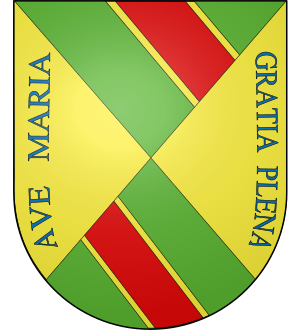Bernardino de Mendoza facts for kids

Bernardino de Mendoza (born around 1540 – died August 3, 1604) was an important Spanish military leader, diplomat, and writer. He served the King of Spain in many ways, from fighting in battles to representing his country in other nations. He also wrote books about military history and politics.
Contents
Life and Career
Early Military Days
Bernardino de Mendoza was born in Guadalajara, Spain, around the year 1540. His parents were Don Alonso Suarez de Mendoza and Doña Juana Jimenez de Cisneros.
In 1560, when he was about 20 years old, Bernardino joined the army of Philip II of Spain. For more than 15 years, he fought in the Low Countries (which are now parts of Belgium, Netherlands, and Luxembourg). He served under a famous commander named Fernando Álvarez de Toledo, Duke of Alba.
Bernardino took part in many important battles and sieges. These included the Siege of Haarlem, the Battle of Mookerheyde, and the Battle of Gembloux (1578). Because of his bravery and success in these military actions, he was honored in 1576. He became a member of the military Order of Santiago, a special group of knights.
Serving as an Ambassador
In 1578, King Philip II sent Mendoza to London as his ambassador. An ambassador is a country's official representative in another country. While in London, Mendoza did more than just diplomacy. He also worked as a spy. He used many secret codes to send his reports back to Spain.
In 1584, Mendoza was asked to leave England. This happened after it was discovered that he was involved in a plan against Elizabeth I of England, the Queen of England. His secret messages with King Philip II, which used a code only they knew, were key to this discovery. When he was leaving, he famously told the English officials, "Tell your mistress [Queen Elizabeth] that Bernardino de Mendoza was born not to disturb kingdoms but to conquer them."
Diplomacy in France
After leaving England, Bernardino de Mendoza spent the next six years as the Spanish ambassador to the King of France. During this time, King Philip II wanted to influence French politics. Mendoza helped carry out this plan.
He worked closely with the Catholic League, a group of powerful French Catholics. Mendoza gave them money from Spain to support their actions. He encouraged them to cause riots and start military campaigns. His goal was to weaken any moderate Catholic groups that wanted to make peace with the Huguenots (French Protestants). Mendoza and King Philip saw the Huguenots as a threat that needed to be removed.
Bernardino's support for the extreme Catholic House of Guise became very well known. Eventually, King Henry III of France demanded that Mendoza be called back to Spain.
Later Years and Writings
In 1591, Mendoza resigned from his role due to poor health. The Catholic League was also facing difficulties at this time. For years, his eyesight had been getting worse. By the time he returned to Spain, he was completely blind. He spent his last years living in his house in Madrid. He passed away on August 3, 1604.
Many of the secret messages he sent to Madrid were only understood much later. Historians found them in the Simancas archives and deciphered them. These messages showed for the first time Mendoza's role in organizing the Paris riots. These riots, known as the Day of the Barricades (May 12, 1588), were presented as a spontaneous uprising of the people. They were timed to happen at the same time the Spanish Armada was sailing.
Bernardino de Mendoza also wrote important books. One famous book about the war in the Low Countries is called Comentario de lo sucecido en los Paises Bajos desde el año 1567 hasta el de 1577. He also published a book about the art of warfare, titled Theórica y práctica de la guerra.
See also
 In Spanish: Bernardino de Mendoza (embajador) para niños
In Spanish: Bernardino de Mendoza (embajador) para niños

